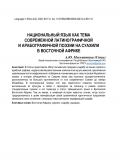The article presents an overview of the Kiarabu written tradition in the Swahili language in Arabic graphics, which has long been an important component of the Muslim Swahili civilization of the East African coast and the adjacent islands of the Indian Ocean, which united since the Middle Ages a number of port cities-sultanates located over a long stretch from the south of modern Somalia to the north Mozambique. During the colonial period, this type of literacy was gradually ousted from the culture due to the transition to the Latin alphabet within the framework of the project standardization of Swahili and its transition to the status of an official language in the British East Africa. Nevertheless, in recent history, there are cases when traditionalist poets, in order to manifest their Swahili identity, continue to record their compositions with the help of new author’s modifications of kiarabu.
